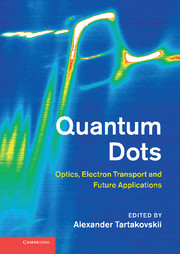Book contents
- Frontmatter
- Contents
- List of contributors
- Preface
- Part I Nanostructure design and structural properties of epitaxially grown quantum dots and nanowires
- Part II Manipulation of individual quantum states in quantum dots using optical techniques
- Part III Optical properties of quantum dots in photonic cavities and plasmon-coupled dots
- 8 Deterministic light–matter coupling with single quantum dots
- 9 Quantum dots in photonic crystal cavities
- 10 Photon statistics in quantum dot micropillar emission
- 11 Nanoplasmonics with colloidal quantum dots
- Part IV Quantum dot nano-laboratory: magnetic ions and nuclear spins in a dot
- Part V Electron transport in quantum dots fabricated by lithographic techniques from III–V semiconductors and graphene
- Part VI Single dots for future telecommunications applications
- Index
- References
11 - Nanoplasmonics with colloidal quantum dots
from Part III - Optical properties of quantum dots in photonic cavities and plasmon-coupled dots
Published online by Cambridge University Press: 05 August 2012
- Frontmatter
- Contents
- List of contributors
- Preface
- Part I Nanostructure design and structural properties of epitaxially grown quantum dots and nanowires
- Part II Manipulation of individual quantum states in quantum dots using optical techniques
- Part III Optical properties of quantum dots in photonic cavities and plasmon-coupled dots
- 8 Deterministic light–matter coupling with single quantum dots
- 9 Quantum dots in photonic crystal cavities
- 10 Photon statistics in quantum dot micropillar emission
- 11 Nanoplasmonics with colloidal quantum dots
- Part IV Quantum dot nano-laboratory: magnetic ions and nuclear spins in a dot
- Part V Electron transport in quantum dots fabricated by lithographic techniques from III–V semiconductors and graphene
- Part VI Single dots for future telecommunications applications
- Index
- References
Summary
Introduction
Colloidal semiconductor nanocrystals were the first model systems to evidence radiusdependent energy shifts of excitonic states caused by three-dimensional quantum confinement (for reviews see e.g. [1, 2, 3, 4, 5, 6, 7, 8, 9, 10] and references therein). Besides the large tunability of optical emission wavelength, such nanocrystal quantum dots exhibit high quantum efficiency q and can nowadays replace organic dyes in various applications, e.g. act as biomarkers or active laser medium. In the broad field of nanoplasmonics, combinations of metallic nanostructures with semiconductor nanocrystals have potential applications in optoelectronics. The enhancement of spontaneous emission rate near metallic surfaces makes nanocrystals attractive candidates as probes of electromagnetic field distribution and nano-antenna effects. Charge separation at the metal–semiconductor interface can be applied in photocatalytic processes as was recently shown for production of hydrogen in multicomponent metal–semiconductor nanocrystal structures [11, 12]. The modification of optical and electronic properties of colloidal nanocrystals close to a metallic surface is a longstanding issue of research and will be reviewed in this chapter, in particular with a focus on the latest developments. We will start with an overview of fundamental properties of colloidal quantum dots along with a presentation of the most recent results in the field of functionalized colloidal nanostructures. We consider semiconductor and metallic nanostructures separately and describe their properties as individual building blocks for future complex nanosystems. In the following sections we deal with coupling schemes of quantum dots to metal surfaces, discuss practical applications in all-optical plasmonic devices and outline perspectives in quantum optics with surface plasmons.
- Type
- Chapter
- Information
- Quantum DotsOptics, Electron Transport and Future Applications, pp. 185 - 202Publisher: Cambridge University PressPrint publication year: 2012
References
- 3
- Cited by



